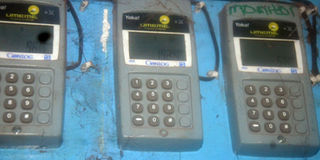Prime
Umeme’s buyout value drops to Shs849 billion

Some of the Yaka meters on Biashara Building in Jinja City. Umeme recoups its investments when these assets depreciate through capital recovery charges. PHOTO/ TAUSI NAKATO
What you need to know:
This figure is subject to an audit by the Auditor General, who will determine the amount the government will pay to the power distributor for the residual amounts it has not recovered from its power distribution business over the last 19 years.
The government’s payment to Umeme’s shareholders when its concession expires in March 2025 has reduced by Shs72 billion since last year, just 13 months before the power distributor handles operations to the government.
This has been established by the Electricity Regulatory Authority (ERA), as the power distributor continues to recoup its investments from power tariffs.
The potential collective sum available to pay off its current liabilities and shareholders after transferring its assets to government is in free fall, with the latter estimating it to be around Shs849 billion at the moment, from the prior Shs921 b that Umeme reported last year.
This figure is subject to an audit by the Auditor General, who will determine the amount the government will pay to the power distributor for the residual amounts it has not recovered from its power distribution business over the last nineteen years.
“The government set up a committee that meets up on a daily basis. It includes the regulator [the Electricity Regulatory Authority] and Umeme itself which has invested tremendously in infrastructure to run its operations in the country,” said Mr Julius Wandera, the director of corporate and consumer affairs at ERA.
Through various inventories, infrastructure, and software, Umeme has collectively invested close to Shs2.6 trillion to run its operations in Uganda efficiently.
As agreed upon by the government, it has been gradually recovering these costs through power tariffs, which as of January this year totaled Shs849 billion.
Capital recovery
In a report to shareholders last year, Umeme stated that during the period, its capital recovery rate climbed from 10.2 percent to 18 percent, which was higher than the average depreciation rate of its underlying property, plant, and equipment (PPE).
The PPE that Umeme has established in the course of operating its business is not owned by the power distributor under the terms of its contract with the government. These assets are even listed on its balance sheet as intangibles.
Instead, it is compensated for its investments through a capital recovery rate set by the ERA which informs power tariffs. And this rate is predetermined by the average depreciation of Umeme’s underlying PPE.
The property, plant and equipment, or intangible assets which underlie Umeme’s operations include substations, low-voltage lines, pole and no-pole service lines, structures and automobiles.
Umeme recoups its investments when these assets depreciate through capital recovery charges, which ERA has allowed in Umeme’s tariff structure.
This subsequently explains why there were elevated prices of energy per unit since last year because Umeme’s capital recovery rate saw a 7.8 percent increase.
The power distributor’s collective unrecovered capital investment will be a financial asset receivable to the utility company’s shareholders when its concession expires naturally.
“ERA reserves the right to determine the capital recovery rate for tariff setting purposes and may, therefore, approve a capital recovery rate different from the weighted average depreciation of the underlying property, plant and equipment,” Umeme stated.
Umeme uses this method to recoup its costs and capital expenditures, so an increase in it indicates that the power distributor is recovering its investments at a comparatively faster rate.
Given that the company is publicly traded, the stock market regulator is awaiting the Attorney General’s final determination to make sure the company fully settles its debts before any shareholder receives a penny.
“At the time of the announcement of the non-renewal of Umeme’s concession, there was a bit of inactivity on the company’s counter because of that lack of information. But we have seen the company attract a lot of shareholders ever since due to that anticipation of the buyout amount from the government,” said Denis Kizito, a director of market supervision at Capital Markets Authority (CMA).
He adds, “The figure that will be certified by the attorney general is the key of what will be the residual value of Umeme’s assets. It will be what is available to shareholders for distribution according to the shares they hold but the concern is whether the company’s current liabilities are all settled.”
Meanwhile, a plan for a seamless handover of operations from Umeme to Uganda Electricity Distribution Company Limited (UEDCL), has already been established by the government.
“As we plan now, the government is interested in recapitalising UEDCL to take on the network. It is also considering a public private partnership with a private company in the power distribution business to enhance efficiency,” Mr Wandera told this newspaper.
UEDCL will maintain a majority shareholding in the partnership and the private sector operator will be selected through a competitive process, which will give Umeme a competitive edge due to its experience in the industry.




